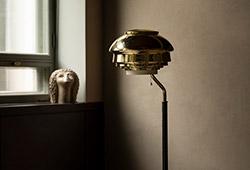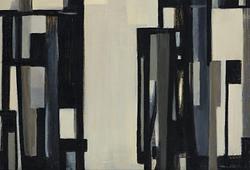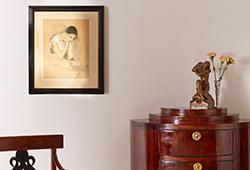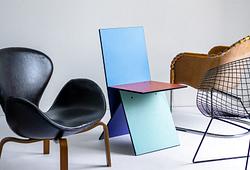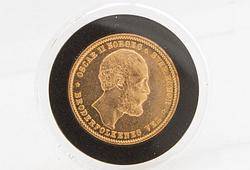Carl Larsson
Porträtt av professor Axel Tallberg (1860-1928) i profil.
Signerad ”Teckning af Carl Larson 1904”. Blyerts och svart tusch på papper 27,8 x 18,4 cm.
Proveniens
Professor Axel Tallberg (1860-1928).
Mårten Sondén (1846-1913)
Rune Jernström (1933-2031) grundare av Jernströms Tryckeri.
Övrig information
Preparatory for a soft ground etching signed ”CL” known in only one impression (Private Collection) (see fig). A small edition of 10 without the signature was published at a later stage (Kruse, Carl Larsson som målare, tecknare och grafiker - en studie (Carl Larsson, painter, draughtsman and etcher - a study), 1906, no. 46, Axel Romdahl, Carl Larsson som etsare (Carl Larsson as an etcher), p. 135, no. 48 and Hjert & Hjert, Carl Larsson - grafiska verk (graphic works), 1983, no 53) (see fig). Although Carl Larsson’s surname is misspelt, with only one s opposed to two s’s, the inscription is surely by Larsson’s own hand, as witnessed by a proof state of the etching in Länsmuseet in Vänersborg, Sweden (inv. no. XLM.16303) inscribed by the same hand, similarly with only one s in Larsson’s surname (see fig). The drawing was unknown to Ulwa Neergaard in her catalogue raisonné of the artists work, but she lists the etching (Carl Larsson. Signerat med pensel och penna, 1999, Vol. I, p. 328, Vol. II, p. 96, under 1904, no 1119 ). According to Axel Romdahl, op. cit., to whom the preparatory drawing was unknown, the portrait was executed in Tallberg’s studio in Stockholm:
"I ett profilporträtt af etsaren och etsningsläraren Axel Tallberg utförda å dennes atelier, upptager Larsson en än gång mjukgrundsförfarandet. Resultatet är ypperligt, mest erinrande om en svartkritteckning i dekorativ men skissartad stil.” (In a profile portrait of the etcher and etching teacher Axel Tallberg made in his studio, Larsson once again takes up the soft-ground procedure. The result is excellent, most reminiscent of a black chalk drawing in a decorative but sketchy style.).
Carl Larsson’s portrait of Axel Tallberg is the only known portrait of him, apart from self-portraits.
Axel Tallberg studied at the Academy of Fine Arts between 1879–1882. In 1882, Albert Theodor Gellerstedt (1836-1914) introduced him to etching. Following his graduation he spent the following twelve years traveling around Italy, France, Spain, North Africa and Germany. During his travels, he made landscape paintings in watercolor and studied etchings. His desire to learn the art of etching resulted in him studying at the Academy of Fine Arts in Düsseldorf from 1885 where he etched his self-portrait in 1886 (see fig), and in England in 1889–1895 to further refine his knowledge of etching techniques. However, at that time it was difficult to learn all the chemical and technical methods of etching as the performers were reluctant to share any knowledge. In London, he got in touch with the Swedish etcher Axel Herman Hägg whom he portrayed in an etching. During his stay in England he lived most of his life in Burnham near Windsor and occasionally worked as an art teacher. From London he wrote a letter to the Academy of Fine Arts in 1893 in which he campaigned for the establishment of a free course in etching and related engraving methods for the Academy's students. The result was that the so-called Tallberg course started in the Academy of Fine Arts' new premises in 1895. The first year was largely financed by grants from the Academy of Fine Arts, the Association for Graphic Arts and the General Staff's lithographic institute. After the successful course in 1895, the grants from the Academy of Fine Arts became sporadic and they could not provide premises for Tallberg and his course activities, so his teaching of etching in the following years led to a casual and uncertain existence in various premises. However, he continued his teaching and received a large number of students for his courses mainly from the art academy, including Carl Larsson, Albert Engström, Ferdinand Boberg, Prince Eugene and Anders Zorn. Carl Larsson attended lessons at his school already in 1896 and again during the spring 1900. In 1901 Tallberg gave a course in etching for the members of the Swedish Artists' Association and several later well-known Swedish artists sought him out during these years to learn etching techniques. In 1908 the Swedish parlament decided to contribute funds to a state etching and engraving school at the Academy of Fine Arts, and in March 1909 the first etching course started with Tallberg as teacher and director of the business. He was appointed deputy professor in 1910 and remained in this position until his resignation in 1926. Tallberg was practically the sole teacher for an entire generation of Swedish graphic artists. Tallberg was the role model for the so-called Falugrafikerna and to some extent their teacher. Although born in Gävle, he grew up in Falun. His own etchings mainly focuses on portraits, King Oscar II, Lev Tolstoy and Theodore Roosevelt, among others. In addition, he executed as many as fifty etchings with motifs from the Old Town in Stockholm. Tallberg worked in several different etching techniques, such as line etching, crayon etching, mezzo-tin, aquatint and sometimes in dry-needle etching. He participated sparingly in exhibitions but was represented at the Graphic Society's retrospective exhibition at the Academy of Fine Arts 1911–1912 and the same association's exhibition at Malmö Museum in 1912 and he participated with ten graphic magazines in the Association for Graphic Art's portfolios. Tallberg worked as an illustrator for both Swedish and foreign magazines and in 1895 founded the weekly magazine Förgät-mig-ej (Forget me not). As a writer he published a number of books, mainly relating to graphic works; Några ord om etsning och andra konstnärliga gravyrmetoder in Grafiknytt, 1912 ( A few words about etching) which were later printed in new editions under other titles, Om måleriets och färgernas kemi: en hjälpreda för konstnärer och museimän (The chemistry of Painting and pigments - a helpmeet for artists and museum curators), 1915, Etsningsskolan 1895-1920: en återblick (The Tallberg course - a review), 1920 , Vår moderna konstgrafik 1895-1920 (A survey of Swedish moder graphic works 1895-1920), 1920, as well as artist monographs on Knut Ander in 1913 and Anders Zorn in 1919. He also participated as a journalist and illustrator in newspaper press and correspondent for the English newspaper The Studio. As an art critic, he appeared in Nya Dagligt Allehanda and a few smaller rural newspapers. He was a member of the Royal Society of Painter-Etchers and of the Royal Archaeological Institute, both based in London.
Mårten Sondén, to whom the present drawing was presented, either by Carl Larsson or Axel Tallberg, was a significant collector and connoisseur of graphic art and worked for many years as chairman of the Association for Graphic Arts, to whose founding in 1887 he contributed greatly. His collection of Swedish engravings and Swedish portraits was the largest in Sweden. Some patrons bought the collection, which included over 50,000 leaves, a few weeks before Sondén's death for SEK 70,000 and distributed it between the Royal Library, the National Museum and the University Library in Uppsala. Sondén was also a performing graphic artist. He is represented at the National Museum with a grotesque old figure of which he made in 1889. Sondén also owned Carl larsson’s original copperplate for his etching of Axel Tallberg (Romdahl, op. cit.). Tallberg’s and Sondéns’s close relationship is witnessed by two etchings Tallberg made of him (see fig).
Konstnär
Carl Larsson räknas som en av de största svenska konstnärerna genom tiderna. Han föddes i Gamla Stan i Stockholm och studerade vid Kungliga Konstakademin åren 1866-76. Efter studierna i Stockholm reste han till Frankrike och bosatte sig i Grèz-sur-Loing, dit också andra konstnärer sökte sig. Där utförde han främst målningar med trädgårdsmotiv. I Frankrike träffade han sin blivande maka Karin Bergöö, som också var konstnär och kom att betyda mycket för hans produktion. Redan under studieåren försörjde han sig som fotoretuschör och som tecknare i pressen. Det var också under studietiden som Larsson lärde känna Anders Zorn och Bruno Liljefors, tillsammans brukar de tre kallas för ABC-konstnärerna. I slutet av 1880-talet fick paret Larsson ”Lilla Hyttnäs" i Sundborn utanför Falun av Karins far och det är där Larssons mest kända akvareller som skildrar hans familj kommer till. Motiven föreställer ofta soliga landskap med badande och metande barn, kräftfiske, måltider i det gröna samt interiörscener. Larsson är bland annat representerad i Nationalmuseum där väggmålningen ”Gustav Vasas intåg i Stockholm” och ”Midvinterblot” fyller trapphallen. Väl representerad främst på Nationalmuseum i Stockholm och på Göteborgs Konstmuseum.
Läs mer




